| |
Summary:
Comet 17P/Holmes shocked astronomers on Oct. 24, 2007, with a spectacular
eruption. In less than 24 hours, the 17th magnitude comet brightened
by a factor of nearly a million, becoming a naked-eye object in
the evening sky. By mid-November the expanding comet was the largest
object in the solar system--bigger even than the Sun. Since then,
the comet has faded back to invisibility. A leading model of the
blast posits a deep cavern of ice changing phase, from amorphous
to crystalline, releasing in transition enough heat to cause Holmes
to blow its top. The comet probably contains many such caverns so,
one day, it could happen again. [ephemeris]
[3D orbit] |
 |
| |
| |
Photographer,
Location |
Images |
Comments |
|
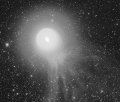
|
Michael
Jäger,
Stixendorf near Krems, Austria
Nov. 4, 2007 |
#1,
#2, more |
tail
image nov 4 UT 19.35 8"/2.75 ASA Astrograph and CCD Sigma
6303 3x6 min filter blue |
|

|
Vicent Peris and José Luis Lamadrid,
Javalambre, Teruel, Spain. 2020 meters above sea level, 0.85"
median seeing.
Nov. 1, 2007 |
#1,
more |
Hello, We are
Vicent Peris and José Luis Lamadrid. We have taken a photo
of the comet Holmes, on the night of 1st - 2nd November.
It's a DSLR photo (Canon 350D), taken with a Takahashi astrograph
(18 cm. f/2.8). It's a combination of 4x10', 26x1' and 30x15"
exposures. All the processing have been made in PixInsight.
We are very happy with the overall result, specially with
the "bubble effect" of the inner and outer comas of the
comet, as well as with the tail structures and inner jets.
Here
is the link to the full resolution image and with 800
pixels wide. |
|
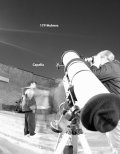
|
Doug Zubenel,
Downtown Kansas City, Missouri.
Nov. 2, 2007 |
#1 |
Dozens of people
stopped during their visits to all the art galleries to
have a look at Comet Holmes Fri. night in downtown Kansas
City, Missouri. Many were able to pick it out of the urban
sky with their naked eyes! Canon Rebel XTi with a 16mm Nikkor
fisheye lens @ f/2.8, 1 second exposure at ISO 400.
|
|
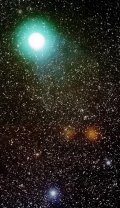
|
Jim Fakatselis,
Backyard in Long Island, Huntington, New York
Nov. 3, 2007 |
#1 |
Had a clear evening after remnants of Hurricane Noel brushed eastern seaboard. Comet was high in the sky approaching meridian, shows part of fan tail. Taken through Baader filter modified Canon Digital RebelXT, Canon 200mm @ f/3.2. Composite of 69 x 45sec images at ISO 800 through IDAS filter, driven by Kenko SkyMemo mount.
|
|
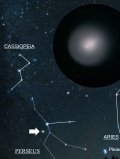
|
Jakob Woisetschlaeger,
Graz, Austria, Europe
Nov. 3, 2007 |
#1 |
The comet was easily seen with naked eyes and a great view in a binocular.
The background image is a composite of two pictures taken with a Canon 300D, 1600 ASA, F4 2 min guided exposures using a Canon 20mm 1:2.8 lens.
The photograph in the upper right I took through my MEADE LX200GPS 10". The Canon 300D was in the focal plane with 20 sec exposure time at ASA 800.
|
|
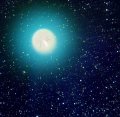

|
Lorenzo Comolli,
Tradate, VA, Italy
Nov. 1, 2007 |
#1,
#2, more |
The comet tail is fan-shaped, with an aperture of about 90°. This is due to the small angle of the tail respect our line of sight (about 17°). The tail is best visible with a blue filter. The tail components are at position angles between 165° and 270°, extending from the optocenter at least 1°. The dust coma is 11' diameter and the gas coma is about 42'.
Tech details: Schmidt Camera 300mm f/2.0 + CCD from a light polluted city. 1-2 november 2007, RGB 2.46 (2 nov) - 23.21 (1 nov) - 20.34 (1 nov) UT. Total exposure 3h46m, in frames of RGB 30:60:120 s each. Central dust coma elaboration with Larson-Sekanina 10°. North is up.
|
|
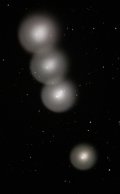
|
Lauri Kangas,
Caledon, Ontario, Canada
Nov. 3, 2007 |
#1,
more |
String of Pearls.
I carefully superimposed and aligned the stars in 4 photos of Comet Holmes between October 29th and November 3rd. I then blended the layers into one image. The resulting image looks like a string of pearls and show the growth of the comet. Data is missing for 2 days due to cloudy weather. Imaged with a digital SLR and a 4" apochromatic refractor at prime focus.
|
|

|
Riccardo Di Nasso,
Pisa, Italy
Nov. 3, 2007 |
#1,
#2,
#3,
|
This is a confront to a new big comet holmes and the Orion, The 2 photo is a Take in the same night and same strument skywacher 80ed pro and canon 350D modificate. The comet it's now grat like Orion!!
|
|

|
Conrad
Pope,
Kelly, North Carolina, USA
Nov. 4, 2007 |
#1 |
This is an image
from Novermber 4, 2007, taken with a Canon 40D modified,
using a 200mm lens @f4.5. Combinations of 30 second, two
minute and 5 minute exposures from ISO 200-1600.Looks like
three tails or a larger tail with streamers. |
|
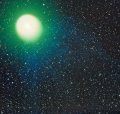
|
Chris Schur,
Happy Jack, Arizona
Nov. 3, 2007 |
#1,
#2, more |
These two images
from our very dark high altitude site up near the Discovery
Channel Telescope. The
first is a stack of short 1 minute integrations showing
the extensive ring structures in the core. The
second image is much deeper and shows the very blue
gas tail. This was a 30 minute shot with the SV80s and canon
XTi |
more
images (Nov. 3-4): from
Mike Holloway of Van Buren, Arkansas; from
Runar Sandnes of Reed, Norway; from
Montse Campas of Obs. Montcabrer - MPC 213 - Cabrils - Barcelona
- Spain; from
Diego Gonzalez of Llanera, Asturias, Spain; from
Ehsan Rostamizadeh of Kerman, Iran; from
Dave Eagle of Higham Ferrers, England;
|
|
|